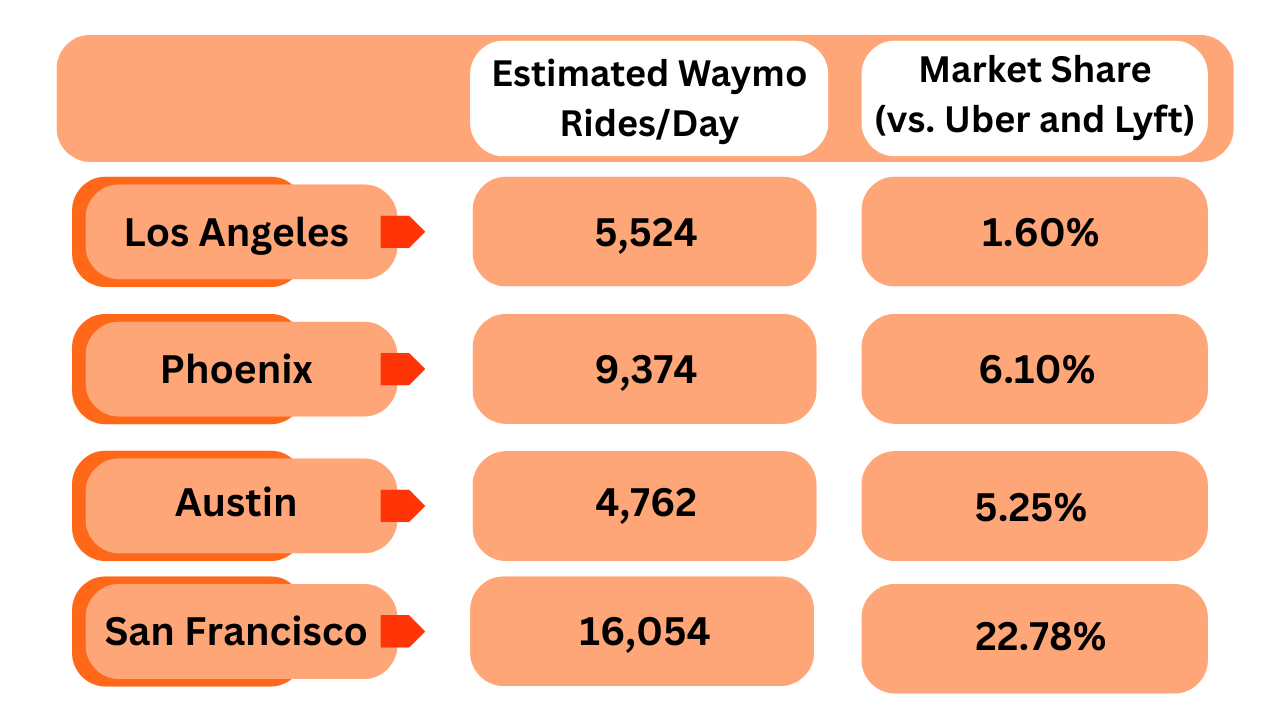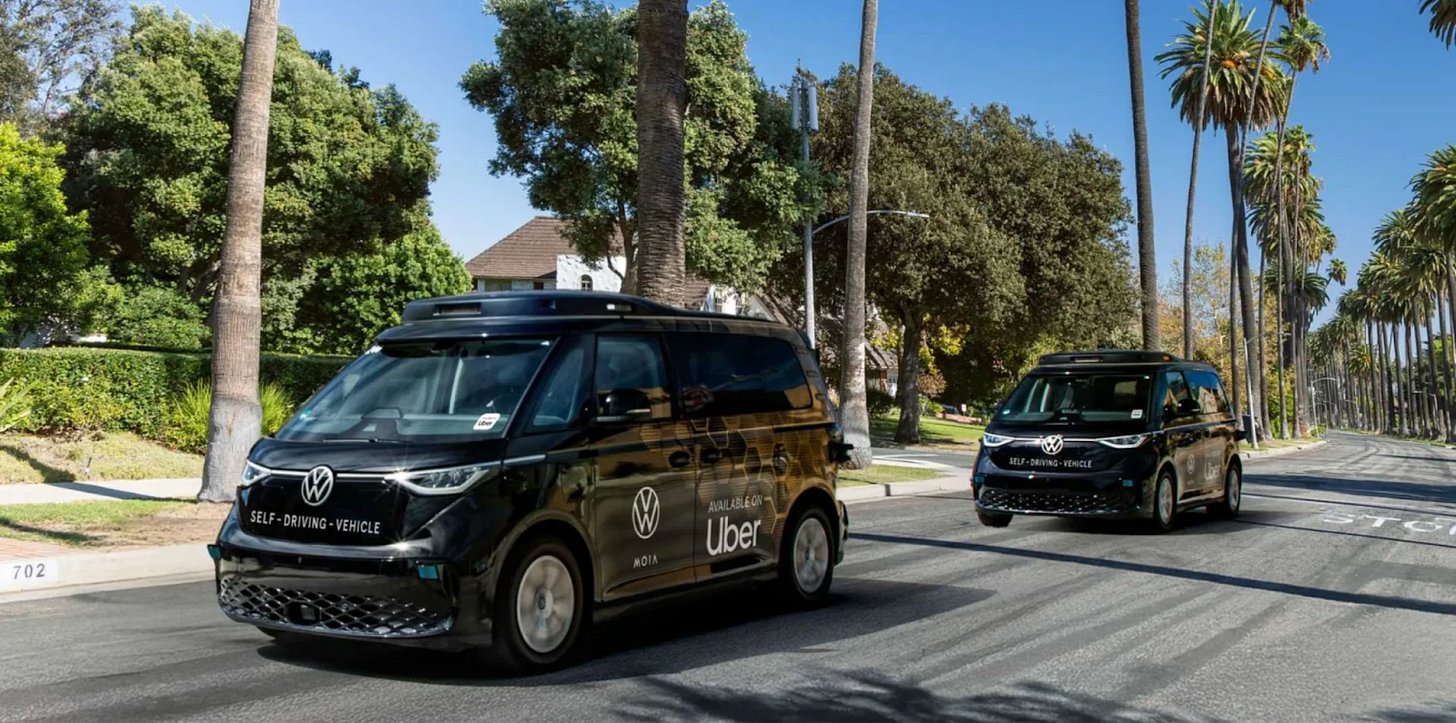Tesla has launched a robotaxi service, but only for employees
Waymo is now doing 250,000 paid trips per week, but the cars in Austin are slammed with complaints, Volkswagen and Uber team up to bring AVs to Los Angeles, and what we know about Zoox
Top Stories of the Week
Tesla has launched a robotaxi service, but only for employees (link). The testing (with a safety driver) comes ahead of a planned robotaxi launch later this summer, and Tesla says they’ve done over 1,500 trips and 15,000 miles of driving so far. CEO Elon Musk also said that he expects to roll out 10 to 20 vehicles on day one of service in Austin in June.
If the launch features vehicles with no safety drivers, I will be impressed. But the other thing I’m watching is who will own the vehicles and shoulder the liability. Waymo employees consistently reiterate how critical safety is to everything they do, but that’s not really Elon’s style. He’s had a lot of success pushing boundaries and doing things his own way, but there’s no getting around the lawsuits and liability that come with owning a fleet of shared vehicles. If Tesla removes the driver and owns the vehicles, that will tell me a lot about the quality of their FSD product.
Waymo is now serving over 250,000 paid trips weekly across San Francisco, Los Angeles, Phoenix and Austin — less than two months after hitting 200,000 weekly trips (link). This number is still a fraction of the tens of millions of rides Uber and Lyft do on a weekly basis but it’s impressive nonetheless. Their growth is clearly accelerating.
I also did some research this week for a client looking at Waymo’s market share compared to Uber and Lyft. Using the 250,000 paid weekly trips figure, here are my findings for Waymo’s rides per day in each market and their market share compared to Uber and Lyft.
I’ll share the full methodology in a future blog post but the gist is I used actual rideshare market data for NYC and Chicago, extrapolated that to other markets based on population, Waymo CPUC data, and the historical Waymo ‘weekly trips’ numbers.
Announcements/Partnerships
Thousands of Volkswagen ID. Buzz vans are going driverless on Uber over the next decade (link). The partnership between Volkswagen and Uber will start with testing in LA later this year and a commercial launch in 2026. The vans will run with human operators at first while the tech gets fine-tuned. VW’s mobility unit, MOIA, is behind the vehicles and the self-driving software, bringing a full-stack approach to Uber’s ride-hailing platform. Uber’s AV partnerships team is the best in the business, and this announcement is good timing too as I recently had MOIA’s CEO Sascha Meyer on my panel at Ride AI. I’ll be sure to publish a recording of that panel soon.
Kodiak Robotics to go public in SPAC deal valuing firm at $2.5 billion (link).
Waymo wants to expand south to San Jose, the Peninsula Hills and other cities (link).
Cool Rides
While in LA last week I couldn’t resist trying out Waymo’s autonomous taxi — and I’m genuinely impressed. Despite the initial hesitation, my family was too (link).
I Tested Amazon's Self Driving Car Zoox in SF (link).
Av/Humans behaving badly
Graffitied Waymo (link).
Man vs AV (link).
Waymo Stuck at Dropoff After Door Left Open (link). While a human was also technically at fault for this one, there’s not a great technical solution since the doors don’t automatically close. I think Waymo will likely have to be strict with passengers about ensuring that all doors are closed before they exit the vehicle, otherwise face a stiff fine/penalty. Similar to how scooter companies make you take a picture of the scooter after you end the ride - this does add some friction though.
Other Stuff
Waymo driverless cars in Austin slammed with complaints (link). Anecdotally, it seems like Waymo is having more issues in Austin than previous markets but it’s hard to tell if Waymo is 100% to blame in each instance. Take this video for example that went viral this week, you can hear two riders complaining that their Waymo was not taking the route to their destination that they wanted — and when they tried calling customer support, the car stopped and left them stuck inside for a few minutes before letting them out after they “threatened to go live on TikTok”.
But here’s what a Waymo representative told The State,
Riders can stop the vehicle whenever they want, and open the doors by pulling twice on the handle. Navarro, or one of her fellow riders pushed the “pull over” button, causing the vehicle to stop on the side of a road with a sidewalk. The group could have exited at any time, and customer support was not needed to open the doors.
This checks out to me as I’ve ‘tested this’ at a red light, and you can get out by pulling twice on the handle (makes sense for safety reasons) so it seems like this TikTok Queen may have gotten this one wrong. Waymo you’re in the clear for this one.
Surge pricing, the scourge of ridehailing, is evolving for the robotaxi era (link, no paywall). Great piece by David Zipper that digs into the genesis of surge pricing; Uber historically used it to lure more drivers onto the road and temper demand. Waymo has a fixed supply though, so all their version of surge pricing can do is temper demand. Here’s a quote of mine in the article:
I think Uber and Lyft have a very strong justification for using surge pricing that gets more drivers on the road and gets you home. Waymo doesn’t have a good justification. They just say, ‘Hey, we’re charging you more because a lot of people want rides, even though we literally cannot add more vehicles to the fleet.’
Here's what we know about Tesla's robotaxi after Musk's earnings call (link, no paywall). During Tesla’s Q1 earnings call on Tuesday, Elon Musk doubled down on the promise of the robotaxi launch in June, starting with a pilot launch in Austin with just 10–20 Model Ys activated via a software update. Elon Musk claims this camera-based, AI-driven system could eventually make any Tesla autonomous — no extra sensors required — with millions on the road by late 2026. He also teased its separate purpose-built “Cybercab” still on track for production next year. No word yet on how riders will hail a ride or how quickly Tesla will expand, but Musk boldly predicts they will take "90-something percent" of the rideshare market.
First look: Driving in Japan! We’ve built one AI that can drive anywhere. The Wayve AI Driver, which has learned to drive in the UK, US, Canada and Germany, generalises those learnings to take on Tokyo’s streets (link).
What we know so far about Waymo competitor Zoox (link).
Beyond the wheel: How Lyft’s Flexdrive is shaping the future of autonomous ridesharing (link).
US Regulator Takes Initial Steps to Boost Self-Driving Cars (link, no paywall).
So this is the rideshare aftermath at Allegiant Stadium during Wrestlemania 41 (link). Good luck Waymo 🫡
CoMotion is heading to Miami on April 29–30, and they’ve pulled together a great lineup of speakers — folks like @Alex Roy (Autonocast), Ron Thaniel from Zoox, and Vignesh Ram of Serve Robotics — plus plenty more voices from both the public and private sectors. If you’re thinking of going, now’s a good time to grab your ticket before they’re gone.
Until next week.
-Harry







“If Tesla removes the driver and owns the vehicles, that will tell me a lot about the quality of their FSD product.”
Would you see that as a positive or a negative?